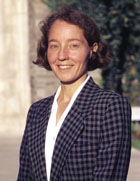EMBARGOED FOR RELEASE FOR SUNDAY EDITIONS, APRIL 9, 2006
Mary J. Sansalone named dean of the School of Engineering and Applied Science at Washington University in St. Louis
April 9, 2006, St. Louis, Missouri — Mary J. Sansalone, Ph.D., professor of structural engineering at Cornell University, will become dean of the School of Engineering & Applied Science at Washington University in St. Louis on July 1, 2006, according to Mark S. Wrighton, chancellor.

Sansalone will succeed Christopher I. Byrnes, Ph.D., dean of the School of Engineering & Applied Science since 1991 and the Edward H. and Florence G. Skinner professor of systems science and mathematics.
“We are extremely pleased to have Mary Sansalone join us at Washington University and lead our School of Engineering & Applied Science,” Wrighton said. “She has an exceptional background in all levels of higher education, from research, to teaching and advising undergraduate and graduate students, to performing many different challenging administrative duties.
“Mary has a keen interest in exploring the interface of engineering and other disciplines,” Wrighton continued. “As such, she has been a very effective collaborator with others in academia, government and industry. We welcome her heartily and look forward to the beginning of her tenure.”
Sansalone is only the ninth dean the School of Engineering & Applied Science has had since 1870. She will oversee approximately 1,100 undergraduate students, 750 graduate students and 89 tenured or tenure-track faculty, 60 research faculty, more than 150 adjunct faculty, as well as more than 300 undergraduates in the joint engineering program with the University of Missouri-St. Louis.
A faculty member at Cornell University since 1987, she earned her Ph.D. in structural engineering from Cornell the previous year. She received a bachelor’s in civil engineering from the University of Cincinnati in 1982, where she studied both civil engineering and literature. In 1999, she earned a master’s in public administration from the John F. Kennedy School of Government at Harvard University.
Sansalone’s primary research interests focus on transient wave propagation in bounded solids, signal processing and pattern recognition, the development of sensing techniques for detecting cracks and flaws in materials, and evaluation of materials and structures. Through a combination of theory, computer simulation, and laboratory and field experiments, she invented a method and an instrument, called Impact-Echo, for nondestructive evaluation of concrete and masonry structures. She laid the theoretical and experimental foundation for this work while a Cornell graduate student. She and her graduate students developed a wide range of applications and invented a field instrument, publishing nearly 90 articles and research reports. Cornell patented the instrument.
In 1995 she worked closely with Cornell’s Office of Technology Transfer and with industry to transfer knowledge about use of the Impact-Echo method and instrument to engineers working on evaluation and repair of structures. She is the lead author of a book published in 1997 on Impact-Echo and its applications. That book has been sold in 17 countries, and translated into Japanese and Chinese. In addition to its use on many private and public works structures, Impact-Echo has been used in the evaluation of historic structures, including the Great Pyramid of Cheops in Egypt.
Sansalone was elected a Fellow of the American Association for the Advancement of Science in 2002, and a Fellow of the American Concrete Institute in 1999. She was a recipient of the Alan Yorkdale Award from the American Society of Testing and Materials in 1997. She was elected to membership in Sigma Xi, the scientific research society, in 1993. She was awarded the Wason Medal for Materials Research by the American Concrete Institute in 1991. She was named a Presidential Young Investigator by the National Science Foundation in 1989, and the National Bureau of Standards awarded her a Special Act Award for outstanding contributions to characterizing stress wave propagation in bounded solids containing flaws in 1986.
Sansalone has also been recognized for her teaching and advising of students. She was named U.S. National Professor of the Year by the Council for the Advancement and Support of Education and the Carnegie Foundation in 1992, and in 1993, Cornell named her a Weiss Presidential Fellow for effective, inspiring, and distinguished teaching of undergraduate students.
From 1993-97, except for a sabbatical year in 1995, Sansalone served as associate director of the School of Civil & Environmental Engineering at Cornell. From 1999-2000 she served as vice-provost for academic programs at Cornell, where she worked with the deans of Cornell’s colleges and on the planning of university initiatives. During the 2002-03 academic year, she took a one-year leave from Cornell to be vice president of planning at New York University, where she focused on academic, financial, and administrative issues brought on by the unionization of adjunct faculty.
Mary Sansalone and her husband Bill Streett, Ph.D., will move to St. Louis in June. Streett is a graduate of West Point and an emeritus member of the chemical engineering faculty at Cornell University.